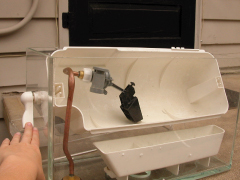Several new technologies offer the promise of increased toilet efficiency and effectiveness in the coming years.
Dual Flush
Dual flush toilets are a technology that has been available for years, but the success of new models from Australia has spurred some U.S. manufacturers to offer their own dual flush models.
Dual flush toilets provide the user with two flush options – a full flush that uses 1.6 gallons of water and a partial flush that uses approximately half the water or 0.8 gallons. A new dual flush model that uses 1.2 and 0.6 gallons per flush is also available.
Flapperless Toilet
Since a substantial amount of water is lost due to toilet flapper leaks, there is great interest in developing technologies for flushing that do not rely of rubber flapper valves.
Niagara Conservation has developed a “flapperless” toilet that employs a tipping bucket design for flushing. The 1.6 gallons per flush (gpf) toilet has the potential to reduce leakage substantially over the life of the product. These toilets are currently being tested in at least one end use study in California and are available for sale.
Waterless Toilets and Urinals
Several products are available that use no water at all. While not designed for the residential market, waterless urinals offer an effective alternative to 3.5 and 1.6 gpf flushometer toilets for office buildings, airports, sports arenas, etc.
Composting and incinerator toilets are completely waterless options for some residential toilet applications. These products are expensive and do require some maintenance, but case studies report that users are very satisfied with these products.
European Electric Toilets
In Europe a new electric toilet technology offers the possibility of water savings, but not energy efficiency. The toilet is constructed with a small electric grinder in the trap.
The grinder, similar to a garbage disposal, grinds all solids and then uses only a small amount of water to remove the waste into the sewer. These products may not be approved by all U.S. health departments.
Improved Toilet Flapper Valves
Replacing the flapper valve in your toilet can be a confusing process. Some toilets rely on a specific type of flapper to achieve their water efficiency rating. Replace the flapper with the wrong product and your toilet no longer performs properly.
The features of these flappers include chlorine resistance, adjustable float for controlling flush volume, universal fit for 2-inch flush valves, high performance, water-saving, and easy installation.
There is a movement now to establish national standards for the design and manufacture of toilet flapper valves to eliminate this problem in the future. It is not known if and when these standards may be implemented. In the meantime, it is best to bring your old flapper with you to the hardware store.
Back to the Future?
Some politicians in Washington have introduced legislation to repeal the toilet standards that were signed into law in 1992. Using the slogan “get the government out of your bathroom” these lawmakers want to permit manufacturers to create toilets than use more than 1.6 gallons per flush.
Unfortunately, this legislation could undo a tremendous amount of time and effort that has gone into designing, testing, and improving toilets so that they successfully use less water. The impact of the 1992 plumbing standards has been estimated at billions of gallons of water saved per day in the U.S. Eliminating these standards would be a giant step backward for water efficiency and conservation.
Toilet Research
Toilets are a popular research subject. They’re an essential part of modern life. Everybody has one, everybody uses them everyday, and everybody has an opinion.
Manufacturers are constantly researching new designs, products, and technologies. To be approved for market, fixtures must go through rigorous tests in which the flushing mechanism is deployed thousands of times.

This toilet model, made by Niagara Conservation, flushes by a tipping bucket rather than a conventional flapper.
The future toilets will be designed to be easier to clean or may even have a self-cleaning feature. These toilets will not just flush the waste, but will also perform additional functions. Currently, an innovative toilet system is under development that can detect any leaks and send alerts to the maintenance staff. This feature will stop water damage and make maintenance of facilities easier and less expensive.
- If You Have No Hot Water Pressure, Here’s What You Should Do - December 28, 2021
- What is the Right Shower Drain Pipe Size? - January 25, 2020
- Wet Vent Plumbing, What Is It? How Do You Utilize It? - November 17, 2019
